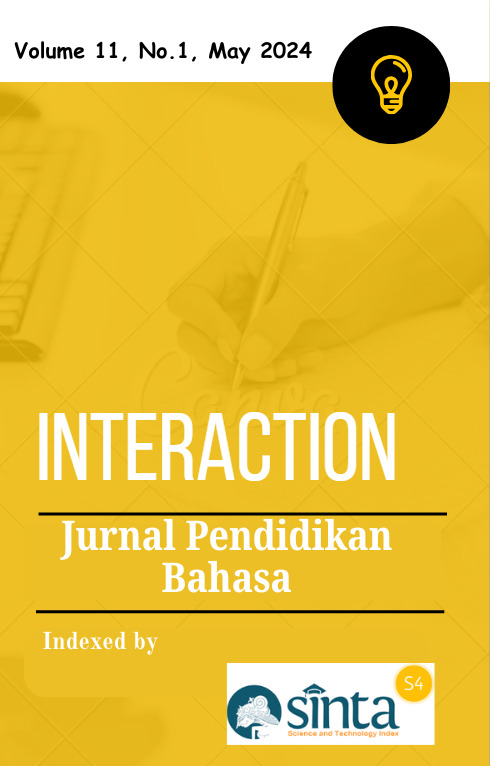A A Systematic Literature Review on Visual Novel as an Engaging Medium for Learning English Skills
Abstract
Visual novels represent an innovative approach to language learning, particularly in enhancing reading comprehension and expanding vocabulary in English. This qualitative research investigates the impact of visual novels on various language competencies, including reading comprehension, vocabulary expansion, and motivation for language learning. The research approach used in this study is qualitative and systematic literature review (SLR) method to identify and evaluate relevant studies on visual novels as an engaging media for learning English skills. The five previous studies that discuss similar topics were collected as a data collection tool. The data collected from previous studies used are in the range of 2015-2023. The study's findings indicate that visual novels serve as a promising and helpful tool for individuals seeking to improve their language skills. The findings highlight the numerous advantages of visual novels, such as increased motivation, better reading comprehension, and improved vocabulary acquisition. The study highlights the potential of visual novels as valuable tools in language education, emphasizing their ability to make language learning enjoyable, engaging, and applicable to real-life contexts. Through their narrative-driven gameplay and immersive multimedia elements, visual novels offer learners an interactive and captivating learning experience. The integration of cultural aspects within visual novels further enriches the language-learning process, fostering deeper engagement and meaningful connections with the language. Additionally, the structure of visual novels accommodates diverse learning styles and proficiency levels, promoting motivation among learners. Furthermore, the interactive aspect of visual novels offers learners an exciting environment for language acquisition that is both engaging and enjoyable.
Downloads
References
Aliv Faizal, M. (2017). The effects of conversation-gambits visual-novel game on students’ english achievement and motivation. Proceedings - 2016 International Electronics Symposium, IES 2016, August, 481–486. https://doi.org/10.1109/ELECSYM.2016.7861054
Bruno, L. (2017). Character-conveyed narrative in Japanese visual novel PC games. 3, 41.
Camingue, J., Melcer, E. F., & Carstensdottir, E. (2020). A (Visual) Novel Route to Learning: A Taxonomy of Teaching Strategies in Visual Novels. ACM International Conference Proceeding Series, September. https://doi.org/10.1145/3402942.3403004
Chan, A. (2021). Visual Novels: Video Game-Style Storytelling as a Multimodal Medium For Language Learning And Instruction. 6.
Character arc - Wikipedia. (n.d.). Retrieved February 7, 2024, from https://en.wikipedia.org/wiki/Character_arc#CITEREFGerke2010
Deci, E. L., & Ryan, R. M. (2000). The “what” and “why” of goal pursuits: Human needs and the self-determination of behavior. Psychological Inquiry, 11(4), 227–268. https://doi.org/10.1207/S15327965PLI1104_01
Dewey, A., & Drahota, A. (2016). Introduction to conducting systematic reviews: online learning module Cochrane Training. https://training.cochrane.org/interactivelearning/module-1-introduction-conducting-systematic-reviews
Dichev, C., & Dicheva, D. (2017). Gamifying education: what is known, what is believed and what remains uncertain: a critical review. International Journal of Educational Technology in Higher Education, 14(1), 1–36. https://doi.org/10.1186/S41239-017-0042-5/TABLES/14
Geest, D. van der. (2015). The role of Visual Novels as a Narrative Medium.
Hemenover, S. H., & Bowman, N. D. (2018). Video games, emotion, and emotion regulation: expanding the scope. Annals of the International Communication Association, 42(2), 125–143. https://doi.org/10.1080/23808985.2018.1442239
Himes, M. (2022). Visual Novels and Literature Visual Novel Based Education in English Literature: A Study on Student Engagement. Press Start Visual Novels and Literature Visual Novel Based Education in English Literature: A Study on Student Engagement, 8(2).
Kar, S. (2023). The Impact of Visuals on Storytelling in Visual Novels.
Kholid, I., Raden, U., & Lampung, I. (2017). Motivasi dalam Pembelajaran Bahasa Asing. English Education: Jurnal Tadris Bahasa Inggris, 10(1), 61–71. https://doi.org/10.24042/ee-jtbi.v10i1.875
Lame, G. (2019). Systematic literature reviews: An introduction. Proceedings of the International Conference on Engineering Design, ICED, 2019-August, 1633–1642. https://doi.org/10.1017/DSI.2019.169
Lee, C. I., & Chang, C. C. (2017). Using the networked peer support strategy to enhance reading comprehension for students with various thinking styles. Eurasia Journal of Mathematics, Science and Technology Education, 13(5), 1501–1515. https://doi.org/10.12973/eurasia.2017.00682a
Matzke, B. (n.d.). LibGuides: Visual Literacy: Visual Literacy. Retrieved February 6, 2024, from https://libguides.ccsu.edu/c.php?g=736311&p=5262743
Mutia, T. B. (2020). The Use of Visual Novel Video Games and Students’ Vocabulary Learning. https://doi.org/https://doi.org/10.37742/jela.v2i1.24.
Nurteteng, N., & Purnama, D. (2023). Cooperative Integrated Reading and Composition (CIRC) Learning Method and Word Mapping in Teaching Reading Comprehension. ELLITE: Journal of English Language, Literature, and Teaching, 8(2), 118-124.
Páez, J. D. (2020). Graphic Visual Novels Impact on Students’ Reading Comprehension Skills. 1–175.
Peo, S. (2019). Visual Development of A Visual Novel.
Prasetyo, R. A., & Kuswardani, R. (2021). Developing students’ reading ability using visual novel for high school students. Journal of Research on English and Language Learning (J-REaLL), 2(2), 132. https://doi.org/10.33474/j-reall.v2i2.11336
Pratama, D., Wardani, W. G. W., & Akbar, T. (2018). The Visual Elements Strength in Visual Novel Game Development as the Main Appeal. Mudra Jurnal Seni Budaya, 33(3), 326–333. https://doi.org/10.31091/mudra.v33i3.455
Putri, A., Aida, N. Z., Putri, R. A., Arrahmah, T. S., & Kusrini, D. (2022). A3! Visual Novel Game as an Audio-Visual Media that Motivates Japanese Language Learning. Proceedings of the Fifth International Conference on Language, Literature, Culture, and Education (ICOLLITE 2021), 595(Icollite), 67–74. https://doi.org/10.2991/assehr.k.211119.011
Ramadyanta, A. N., Sanjaya, A., & Widodo, D. W. (2021). Aplikasi Game Visual Novel Sebagai Alternatif Belajar Bahasa Inggris Menggunakan Media Aplikasi Ren’py. Prosiding SEMNAS INOTEK (Seminar Nasional Inovasi Teknologi), 5(1), 111–118. https://proceeding.unpkediri.ac.id/index.php/inotek/article/view/914
Smiderle, R., Rigo, S. J., Marques, L. B., Peçanha de Miranda Coelho, J. A., & Jaques, P. A. (2020). The impact of gamification on students’ learning, engagement and behavior based on their personality traits. Smart Learning Environments, 7(1), 1–11. https://doi.org/10.1186/S40561-019-0098-X/FIGURES/2
Suyana, A. D. (2016). Improving Students’ Reading Ability by Using Visual Novel Entitled Invisible Me ( A Classroom Action Research at the Eighth Grade Students of SMP N 1 Wonoboyo, Temanggung in the Academic Submitted as A Partial Requirements for the degree of Sarjana in Isl.
Visual novel - Wikipedia. (n.d.). Retrieved February 1, 2024, from https://en.wikipedia.org/wiki/Visual_novel
Wangi, W. I. (2015). Multimodality in Simulation Games: Vocabulary Learning through Visual Novel. Universitas Kristen Satya Wacana.




.png)



22.png)
